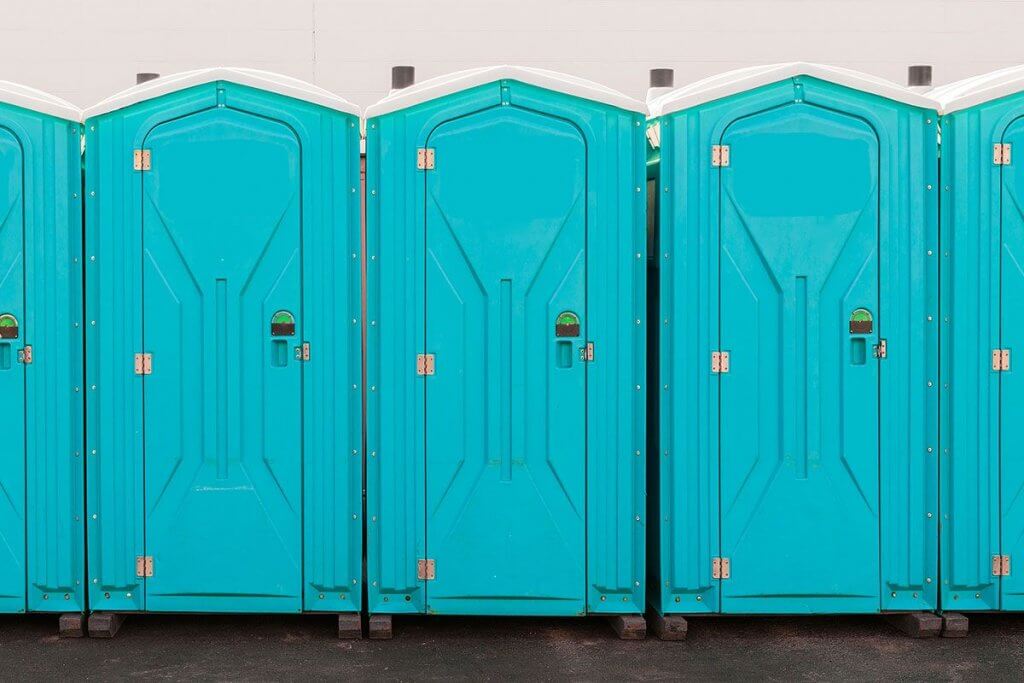
How Pop Cultural Views Have Changed Towards Porta-Potties
For some, portable bathrooms are not necessarily a favored topic of conversation despite the fact that using one is a natural process and part of life. Some thing about it is taboo and distasteful and the topic is often avoided in polite conversation. It should be noted that attitudes are mind-sets that concern the way we view things. Depending on where we live in the world and the culture in which we were raised, our perceptions about human waste and portable toilets will differ.
Figures of speech and euphemisms are reflections of cultural attitudes. ‘Passed away’ or ‘kicked the bucket’ are indirect, less harsh and maybe even less final than ‘died.’ Synonyms for porta-potties somehow deflect their purpose. The porta-john; porta-kybo; port-o-let; port-a-san; sani-privy; latrine; head; privy; honey bucket; WC (water closet); outhouse; porta-loo; john, and Johnny-on-the-spot are prime examples.
The main difference between a positive and negative attitude can result in the success or failure of a new and untried technology or a product. According to a 1997 study conducted by Drangert and others, perspectives on the topic of human excrement may vary from culture to culture, but every social group has its own accepted policy and norms of conduct that vary with age, sex, marital status, class, education and religion.
Porta-potties are often the last resort when it comes to members of the human race using them to meet their needs. They have earned a bad reputation, becoming synonyms for words like vile, smelly, and disgusting. Their place in pop (or should we say, poop) culture is slowly evolving, but many people are still mired in the belief that they are unhealthy and unpleasant places to frequent. While there certainly are porta-potties that present their own smell-o-rama horror matinees, there are many more that are fresh and clean; it all depends on how well they are maintained and of course the effectiveness of the odor neutralizing products that are used to maintain them.
Society and pop culture are harsh critics of negative impressions. One bad experience of closing the eyes and holding the nose can turn a person off forever from porta-potties. Still, if you think about, it isn’t like touching that proverbial stove and getting burned because in that instance the same thing will always cause the same result. This is not the case with portable toilets, which have changed for the better over the years.
Attitudes About Human Waste
Attitudes about human waste reflect feelings about porta-potties and they vary from country to country and even region to region within our country. In rural settings, the outhouse or privy is as much a part of daily life as eating and drinking, but these structures are always separate from the house, and even though the reason may be related to a lack of proper plumbing, repeated use implants in the mind of the user that they don’t belong inside, and that there is something about their use that should be kept secret and separate.
The ancient world had its attitudes about human waste, some of which were highly advanced. The idea of recycling waste as fertilizer was first practiced some forty centuries ago by the Chinese, who had a highly advanced system known as “night soil” management, that protected human health. (This system refers to the nightly removal by special workers of feces without dilution with water from cesspools, pit latrines and privies.)
In imperial Rome, public toilets, also known as foricae,were open and considered social settings and gathering places for group discussions and gossip. The idea is positively alien to today’s culture and the reason is perhaps found in the concept of privacy, which is elusive and varies from culture to culture. In Egypt, portable toilets were installed in tombs for use in the afterlife. In one excavation, archaeologists discovered a wooden stool with a slot in the middle and a pottery jar beneath it to catch the waste.
Respecting And Recycling Human Waste
Taboos concerning human waste are often imprinted below the level of consciousness and deeply implanted cultural norms take their toll on hindering the development of access to sanitation and subsequent human and environmental health. According to Steve Sugden from the organization, Water For People: “In more developed areas of the world we have forgotten the horrors of using a disgusting toilet and we now take for granted that toilets are comfortable, well lit, smell-free, private, pleasant places to defecate. They are places where we can go in peace.”
Slowly, attitudes of disgust towards human excrement have eroded and morphed into the idea that along with urine, they are vital sustainable resources that can be recycled back into the environment. According to the United Nations, 2.1 billion people do not have access to safe drinking water, while 80% of our wastewater is discharged into the environment without treatment or reuse.
A British “poo bus” recently went into service powered bybio-methane energy derived from human waste at a large sewage plant. This and other recycling projects symbolizes an important factor in human culture; that is, the idea that we give back to Mother Nature all of the nutrients within our own waste as a matter of planetary duty.
According to Time Magazine, the human race produces 290 million tons of feces and 1,98 billion liters of urine every year. On an individual level, every person on earth produces roughly 500 liters of urine and 50 liters of feces annually. These two products contain enough nutrients to grow most of the plants required to feed one person. Human waste is rich in nutrients that can be used for the production of fuel. According to The World Bank, we will need toproduce at least50% more foodby the year 2050 in order to accommodate a world population expected to reach 9 billion.
Microbes beyond yogurt and other socially accepted fermented foods may well be an acquired taste, but it is the wave of the future. Peter Ruhdal Jensen, a researcher at the Danish Food Institute stated: “Microbes can produce high quality proteins for food applications and they are highly competitive…They can also be used more as a protein supplement than as a main food staple.”
Urine As A Source of Beer
The notion of recycling waste for fuel and food for plants may seem to be implausible as well as revolting to many, but it is an idea whose time has already come. An ideal example of the successful indirect reuse of urineis the 2015 Beer Cycling Project sponsored by the Council of Agriculture and Food of Denmark (DAFC), with the collaboration of the Danish company, Nørrebro Bryghus.
Researchers collected 54,000 liters of urine from receptacles at a large music festival and this urine was utilized the following spring to fertilize fields harvesting 11 tons of barley malt. The cereal was used in 2017 to produce 60,000 bottles of Pilsner beer that were marketed to amuse under the name, Pisner.
The Birth of The Portable Toilet
Born during the trying times of World War II, like many other engineering advancements, the portable toilet began as a project for the war effort. According to the Portable Sanitation Association International (PSAI), temporary, sturdy and sanitary portable toilets became a necessity in the midst of establishing military bases and transporting personnel into areas lacking facilities. They were large, heavy structures made out of wood or metal, and were a challenge to transport from site to site.
Porta-potties have been evolving since their first appearance, enhanced by innovations in industrial science, such as the introduction of plastics and other lightweight polymers. Each subsequent generation of porta-potties has been an improvement over the original prototype.
Wooden constructions gave way to lighter materials such as fiberglass and polyurethane toilets and deodorizers helped keep them clean and odor-free. Still, the molded design, although a great improvement, had its problems. For one thing, the material was dark and no light could penetrate. For another, the units were more expensive to transport because they were not designed for stacking on flatbed trucks.
Despite visible improvements, for many people a porta-potty is and always will be that old proverbial port in a storm, to be avoided at all costs except when absolutely necessary. And all must remember that prime rule to never, ever look inside the tank. There is no disguising the revolting vision and stench of human waste. The invention of the portable restroom deodorizer known as the “blue liquid” does mask the smell and is responsible for transforming portable potty usage into a more pleasant and environmentally-friendly experience than might otherwise be the case.
Today, the sky is the limit when it comes to porta-potty options. In some cases, the first luxury restroom trailers that were made in Columbus, Ohio, back in 1984 have become the new standard. They often resemble bathrooms you might expect to find in someone’s home or office building. Innovations in the manufacturing process have brought about advances in technology and have also provided for easier construction methods. These restroom trailers are equipped with running water, sinks and sometimes, even heating and air conditioning. Today there are a few dozen manufacturers of luxury restroom trailers around the worldand they are often standard fare at special events,
Porta Potties And A Throwaway Society
One unexpected societal aspect of the porta-potty is that it has become a deposit for unwanted things. In 2016, residents of Macomb Township, Michigan, got the shock of their lives when a construction worker discovered their mail inside a porta-potty. The USPS delivery person deliberately deposited hundreds of checks, holiday cards, store coupons and other items inside the public toilet! To add insult to injury, all of the correspondence had turned blue because they had absorbed the color of the odor-reducing agent that had been added to the toilet.
In 2015, in Ypsilanti Township, Michigan, one James Francis Mazor provided evidence of his own crimes when he inadvertently took a few ‘selfies’ as he hid a camera inside a coffee cup left in a public toilet at a county fair. The police found him easily, as the only likeness caught by the camera was the pervert’s own.
Surco And The Portable Toilet Industry
We made our mark on the portable sanitation industry horizon with the addition of the deodorizer known as the “blue liquid,” which was a great improvement over previous products that contained noxious formaldehyde. This product alone transformed the portable restroom experience into one that was far more comfortable and environmentally friendly than before. Combined with the power of our vapor phase, odor neutralizing additive, Metazene, the blue liquid eliminates smells of waste and provides air freshening for up to seven days, as it is not flushed away after every use.
Trends in pop culture are more and more concerned with eco-friendly strategies and solutions. Consumers demand that products and services for all types of industries remain both green and sustainable. Saving the environment for future generations has been a consistent mantra among concerned activists for the last half century, and Surco has always been at the forefront of this mission, even before it was fashionable to do so. Eco-friendly toilets are the direct result of sustainability awareness.
Using an eco-friendly toilet immediately conserves water, energy and natural resources. “Green” toilets created by any earth-conscious company require sustainable deodorizers and support products. In every way, they are a boon to mankind. They restore vital nutrients to the earth that are essential to sustainable agriculture.
Our enduring success over the last seven decades is no accident. It is the culmination of hard work and constant innovation, aided by cutting edge research technology. In addition to vast array of odor neutralizing products, which include dry toss packets, solid wafer air fresheners, spray and wash down solutions as well as the most effective pumper trick exhaust deodorant, we sell consumer gratification, trust and peace of mind to its many satisfied customers. Our calling, although quietly stated, is impressive and has remained unchanged since our inception. It is to provide a sharply reduced carbon footprint and a clean bill of environmental health for all the world’s children and grandchildren.
Call our team today! We’re here to help.
Final thought on portable toilets:
Quote Found On A Porta Potty Door: He who enters leaves all hope behind ~ Dante Alighieri
Become A Distributor Of Our Portable Sanitation Products
We’re actively looking to eliminate bad odors the world over! Whether you’re an existing PT operator, or someone looking to venture into the portable sanitation industry, don’t hesitate to contact our team for more information about representing Surco’s products anywhere throughout the world. If you live in Mexico, South Africa, Brazil, Chile, Europe, Australia or any other country, send us a message!




